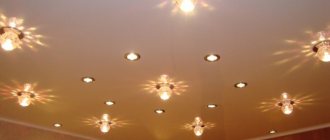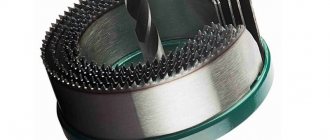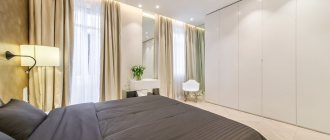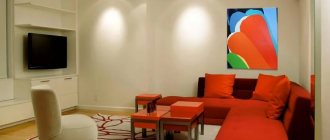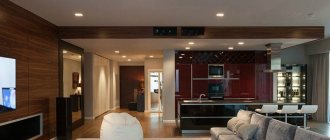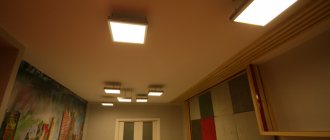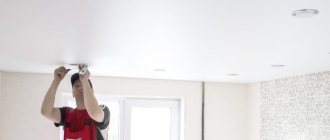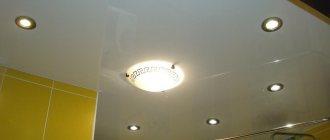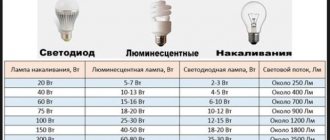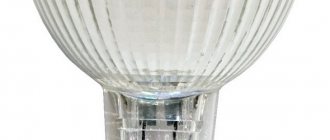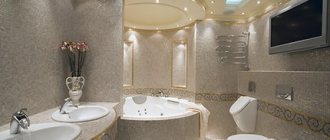Types and types of point light sources
The modern consumer does not have to be limited when choosing these light sources. Each brand specializing in lighting products has many different models. All of them are divided into two types according to the installation method. There are overhead and recessed ceiling spotlights.
The use of overhead devices is advisable if it is necessary to create a modern lighting system without affecting the dimensions of the room. These models can be fixed on concrete and brick surfaces. There is no need to equip hanging, tension systems. For surface-mounted spotlights for ceilings, the size of the body with the diffuser is larger than the dimensions of the mounting platform. She disguises herself and remains invisible.
Ceiling spotlights can be fixed on any surface
With the growing popularity of stretch and suspended ceilings, built-in light sources have become in particular demand. These models have a wide range of applications. They can be mounted:
- in tension systems;
- on plasterboard and panel ceilings;
- in a furniture partition;
- in the niches of the walls.
In addition, these devices are used in the design of stairs, floors, bar counters, swimming pools, etc.
Spotlights are used in the design of stairs
Design Features
The high consumer demand enjoyed by surface-mounted and recessed ceiling spotlights forces manufacturers to constantly expand their range and modify models. Now there are different types of structures on the market. One of the important indicators of devices is adjustment. It determines the comfort of use and the purpose of the device.
In addition to standard devices that provide light flow in a certain direction with a specific intensity, the range includes point light sources:
- with a rotary and retractable mechanism;
- gimbals;
- downlights;
- spots.
The presence of a rotary and retractable mechanism allows you to adjust the direction of the light flux and provide comfortable lighting in the desired area. Gimbal designs include multiple light sources. They are equipped with adjustments to select the desired lighting intensity and direction of flow.
Swivel and retractable spotlight
Downlights are used to create accents in the interior. They create effective illumination of certain objects and areas.
Downlights create effective illumination
Spots are very popular now. These devices have manual adjustment of the direction of the light flow. In this category, you can choose a recessed and surface-mounted spotlight for the ceiling. The product range is large, including models of different shapes, sizes, and design styles.
Spots allow you to change the direction of the light flow
Types of lighting fixtures for the ceiling
You should think about how to organize ceiling lighting and what lamps will be used for this at the stage of finishing work. There are several types of lamps.
The chandelier is an everyday classic. The main thing you should pay attention to is the weight of the product, since some ceiling surfaces, for example, drywall, may not withstand fastening.
Chandeliers have a diffused light output, so one will be enough for the entire area of the room. This is a fairly universal type of lamps, so they are suitable for multi-level structures and inclined surfaces.
Spot lighting devices of built-in or external type - external ones shine more brightly.
Such pointers have an undeniable advantage - ease of installation. However, there are often cases when ceiling surfaces, usually tension ones, are damaged by such light sources.
Note! Sushi and rolls: delicious dishes delivered to your home
Lamps with directional luminous flux - illuminate a specific area with light. Often used to illuminate the working kitchen area, or to adjust the area of the room.
LED (neon) strip – used for hidden lighting of ceiling structures. This tape is placed inside the cornice. It is used in any room except the bathroom, since high moisture is contraindicated for this product.
Lamp arrangement
All spotlights have a similar design, including:
- mounting base;
- housing with diffuser;
- Light source;
- connecting cable.
Arrangement of spotlights
The model range of these lighting products includes various modifications with more complex designs and additional devices. Built-in and overhead ceiling spotlights can be adjusted by remote devices. There are models with an extended lighting angle, equipped with dimming that corrects the illumination. Lamps differ in the level of protection from dust and moisture, which determines the scope of their intended use.
Various modifications of ceiling spotlights
Light sources in spotlights
Various types of lamps can be installed in these lighting devices. Manufacturers' products include incandescent, halogen and fluorescent light sources. All of these devices have certain pros and cons. But the best option is LED ceiling spotlights. They have several obvious advantages that set them apart from other light sources.
LEDs:
- have maximum light output;
- use electrical energy economically;
- create uniform light;
- have the longest service life.
LED ceiling spotlights
These devices have another important advantage. The LED recessed ceiling lamp can be installed in tension systems without fear for the integrity of the canvas. During operation, these light sources practically do not emit heat and do not have a negative impact on the structure of the polyvinyl chloride coating.
Ceiling recessed luminaire can be installed in tension systems
Types of recessed lamps
An important point is that the manufacturer’s recessed home lighting comes in series. Each type has its own line, its own varieties.
- This is important because often lamps are installed not in one room, but in several rooms, and in some places you need a more powerful lamp, but in others you can get by with a less powerful one, but you would like to keep one design.
- Thus, you can take lamps from one line and throughout the entire apartment, everything will be the same throughout the room and object.
- Another point why it is important to choose lamps from the same series is that lamps from different series light up asynchronously.
This happens due to different components, different equipment, different drivers, and their startup is different. Even if the launch differs by a fraction of a second, it will still be visible.
Pros and cons of using spotlights
The main advantages of using these devices in the interior can be seen in numerous photos of spot lighting for ceilings. Using such light sources you can:
- create a system of main or additional lighting;
- perform zoning, provide lighting for a certain part of the room;
- give the interior the desired mood and character.
The compactness of the devices and installation features allow the lamps to remain virtually unnoticed. They have no effect on the interior. Therefore, you can use them in any design. The assortment also includes models with expressive decor that can decorate the interior, support, and emphasize style.
Ceiling spotlights will fit into any interior style
In the photo of ceiling spotlights you can see how well these devices zoning a room. This lighting system allows for efficient use of electricity and provides light only where it is needed. The advantage of these devices is the specific distribution of flows, eliminating the formation of shadows. This is important if you need to equip a workplace to perform small operations.
Spotlights provide room zoning
The use of recessed ceiling spotlights guarantees a reduction in electricity costs. LED and halogen lamps consume minimal amounts of energy. Additional savings are ensured by the use of lighting only in the required areas and the long service life of the light bulbs.
The advantage of these devices is the unlimited choice of installation location. Overhead and recessed ceiling spotlights can be placed in any area, decorating arches, niches, etc. This versatility makes it possible to create a unique, interesting design in a room.
Spotlights create a unique design in a room
LEDs can have a white or yellow, colored glow. This factor expands the possibilities for implementing creative projects. With the help of warm, cold tones, shades of light, you can give the interior different characters, create a comfortable atmosphere, taking into account personal preferences.
The disadvantages of built-in and surface-mounted spotlights for ceilings include a certain complexity of installation and the need to develop a professional installation diagram. In addition, when using models with 12V lamps, you need to additionally purchase a step-down transformer. But these shortcomings are not a big deal.
Basic rules for selecting point models
A large assortment of built-in and surface-mounted spotlights can create certain difficulties when choosing. If it is necessary to install these devices in suspended, tension systems, it is necessary to decide on the type and quantity in advance. Wiring for these light sources will be mounted under the ceiling covering; appropriate holes must be made in the ceiling coverings.
When choosing recessed and overhead spotlights for the ceiling, you must focus on the following criteria:
- purpose of the point light system;
- required power;
- interior style.
Spotlights serve as main lighting
These light sources can serve as main lighting. In this case, you should accurately determine the power and select the location of the lamps that provides high-quality lighting for the entire room. Often these lighting devices are additional and are mounted along with the ceiling chandelier. With such operation, less power of devices is required, and there will be no need to install many light sources. Using spot devices, only a certain area can be illuminated.
Installation of spotlights together with a ceiling chandelier
In the photo of spotlights on the ceiling, you can choose the appropriate product design. In the modern range of models, it is easy to find successful options for any style. Cases and diffusers differ in design and decor. You can choose discreet, laconic lamps, original products with complex designs.
Choosing lighting for a stretch ceiling
When starting to design, it is important to determine the current lamp. With proper organization of lighting, the comfort of the room will increase. You need to choose based on the decorative parameters of the room and the amount of natural light.
There are 3 types of chandeliers on the market, which differ in the type of attachment to the ceiling:
- Hanging;
- Built-in;
- Ceiling-mounted.
Suspended ones are attached directly to the ceiling using a hook and a strip. The fixation is reliable, durable, fastening elements are not visible. The disadvantage of the system is that the chandelier is mounted to the bar with screws on top of the canvas. This leads to two disadvantages:
- The fabric may tear due to tension and uneven openings;
- Using incandescent or halogen lamps may cause the plastic to melt.
Hanging chandeliers are rarely used in residential premises, but are popular in cafes, restaurants, and bars. They give a large amount of light and cover huge areas.
Embedded systems are almost invisible, as they merge with the panel. A base is mounted on the ceiling in advance. After installing the ceiling, a hole is made in the fabric. A lamp with special springs is inserted into it. They straighten and tightly fix the body. Additionally, a decorative overlay is placed on top.
Visually, the light source completely merges with the surface. It looks laconic, no screws are used. Suitable for residential buildings, they allow you to zone a room. Spots are mounted in a group so that the light flux is larger. Often equipped with a fluorescent flux regulator.
The invoices got their name due to the specifics of the fastening. They are literally superimposed on the fabric. The type of fastening is similar to the previous type. They do not spoil the design of the room.
They can have a rotating (it is possible to manually adjust the direction of the light) and a non-rotating design.
Determining optimal power
Determining the required power depends on several factors:
- purpose of the system;
- room area;
- ceiling height;
- lamp parameters.
The use of recessed or overhead spotlights for ceilings as the main lighting requires calculations according to general rules. On average, a 35W light source is installed per 2m2 of area. If this is additional lighting, the indicators of the ceiling chandelier are subtracted from the total power. When creating comfort in a certain area, the fundamental calculation criterion is its area.
The number of spotlights depends on the size of the room
The number of light sources required depends on the type and power of the lamps. Halogen, traditional, LED recessed spotlights have different parameters. Many models are designed to accommodate any type of lamp.
Recommendations for lighting design
Everyone can decide for themselves where to place the lighting fixture. In this case, it is better to follow a few basic rules.
You can always add a light accent to a room to significantly improve comfort. For example, you can emphasize a work area, a play area, or a place to relax. If you like to read books, you can organize a reading area for yourself. A spotlight can autonomously change the light power in a specific area.
Additionally, you need to remember that:
- The lamps are placed at a distance of at least 30 centimeters, since a smaller gap will worsen the dispersion;
- The distance from the walls should be at least 20 cm.
- On average, a spotlight can illuminate 2 square spaces, but, depending on the power of the lamp, the indicator may float;
- With a large ceiling area, it is possible to combine different types of lamps into groups, which is useful in one-room apartments and studios.
Recessed luminaires for suspended ceilings must be LED. Their heating temperature is low. Halogen or incandescent bulbs increase temperatures and melt the fabric. This may damage the panel and the device. According to the requirements of the PUE, the control unit must be located in a place with free air exhaust to prevent overheating of the microcircuits.
Lamp placement options
There are no strict restrictions or recommendations regarding the placement of these devices. However, you need to carefully develop the installation diagram. The comfort of the interior and its attractiveness depend on this. Numerous photos of spotlights on the ceiling will help you find the best option.
You can develop an original placement system and create lighting decorations using such devices. But if you need to create functional lighting, it is worth considering the options that are shown in photos of spotlights. The most popular schemes are:
- rectangular;
- parallel;
- cruciform;
- arcuate;
- chess;
- square.
Placing recessed ceiling spotlights around the perimeter of the room is the best option for creating additional lighting. Light sources can be turned on simultaneously with the chandelier to create maximum intensity. This option is used when receiving guests, organizing a banquet, or a holiday. Turning on only spotlights allows you to create a cozy, intimate atmosphere.
Placement of ceiling lights around the perimeter of the room
The parallel layout is suitable for main lighting provided by point light sources. The arrangement of lamps in several rows allows for high-quality lighting of the premises and creates proper comfort. Photos of spot lighting for ceilings in this version can often be seen in galleries of modern interiors.
In a small room with a low ceiling, it is not practical to use pendant chandeliers that take up space. An excellent option for such a room would be a cross-shaped design with LED spotlights. Single models are placed in the corners, and a gimbal structure is located in the center.
A parallel lighting scheme allows for high-quality lighting of the room
Arc-shaped placement of light sources is usually used to create lighting in a specific area. This technique allows you to visually soften excessive straightforwardness and severity. This installation scheme for LED spotlights is used to design transitions between levels in tension structures.
In some cases, a rational way is to arrange the light sources in a checkerboard pattern. Such options can be seen in the photo of spot lighting of ceilings in a kitchen with an island interior, where it is necessary to provide high-quality lighting to all areas, in the dining room, and hall.
A rational way to place light sources in a checkerboard pattern
Placing appliances in a square shape is used for small rooms. This is the optimal scheme for a hallway or bathroom.
Ultra-thin luminaires
There are thick lamps, and there are ultra-thin panels. An ultra-thin lamp has a ruler located inside along the perimeter and it shines inside the lamp. There is a reflective surface, glass, frosted glass. Accordingly, light enters the lamp, is reflected and goes out.
Compared to spotlights, they are less bright. When it is not possible to use bright lamps, you can simply use more thin ones. Also, ultra-thin ones have one advantage: since it is not direct light, they glow, the light is very soft and there is practically no glare effect.
Methods for installing lamps in tension systems
When choosing recessed or surface-mounted spotlights for suspended ceilings, it is necessary to take into account the installation method of these devices. It depends on the interior design project. Lamps can be mounted:
- under the ceiling covering;
- at canvas level;
- below the ceiling material.
Overhead spotlights on the ceiling are installed to create decorative lighting and create spectacular lighting effects. Using LED devices, a “starry sky”, colored patterns to create a romantic atmosphere, etc. are created.
Overhead spotlights on the ceiling
Light sources located on the same level with the suspended ceiling create additional or main lighting for the room. This technique is often used in interiors in modern styles, where conciseness is encouraged.
Lamps on the same level with a suspended ceiling in modern interiors
Installation of lamps protruding beyond the level of the canvas is carried out if rotating models are used, allowing you to change the direction of light. This method is used when the devices have an original decorative design and are a decoration of the ceiling.
Rotating models of ceiling spotlights
Main characteristics
Before purchasing LED light bulbs, you should decide how the light will fall in the room and what placement they plan to have relative to the ceiling.
If at the same level, the luminous flux will be narrowed, since the devices are partially closed. Such lighting is suitable, for example, when zoning a room. But it should be taken into account that with such a hidden installation there is a risk of damaging the tension surface during repairs.
If the lighting fixtures are placed below the tension structure, the lighting will be more diffused and evenly distributed along the entire perimeter of the room.
Spotlights are divided into two types:
- rotary;
- not rotary.
What functions each type has is indicated by their name. The first one has great potential. The built-in rotary ring makes it possible to direct the flow of light in the desired direction. This way you can illuminate the far corners of the room, which often remain shaded under normal lighting.
If this function is not needed, then choose the second type, when the light is directed straight down. This is used for a bedroom, or if you need to divide the room into zones.
The designs of non-rotating spotlights are more durable and installing them in a suspended ceiling is easier.
Lighting fixtures are determined by the type of light source:
- halogen lamps;
- with filament;
- LED
The last type is the most popular because it gives a high level of brightness with little heating, lasts a long time and makes it possible to change the shade of the backlight.
In addition to luminous flux and power, no less important points when purchasing are the type of base, supply voltage and degree of protection of the device.
Halogen lamps, as well as LED ceiling lamps, in some versions may require a power supply when connected. Then you need to think about where to install this block. It would be better if you mount it near the eaves, in a niche. Then, in case of replacing the battery, it will be possible to do without complete dismantling.
Point lights in different styles
The compactness of spotlights and the ability to make them invisible make light sources an excellent option for high-tech and minimalism. These styles are characterized by maximum functionality; they do not use unnecessary decor. In the photo of spotlights on the ceiling you can see many such options. The devices fit perfectly into the design and highlight the style features.
Spotlights are ideal for a minimalist style
In the assortment of these lighting products you can find successful options for the following styles:
- classic;
- country;
- Oriental;
- Provence, etc.
You can look on the Internet for photos of spotlights with designs that correspond to the canons of these trends. The cases of such models are decorated with gilding, covered with engraving, stones, and metal patterns. Crystal is used in production for diffusers, decorative pendants, etc. This allows the models to adequately decorate the interior.
